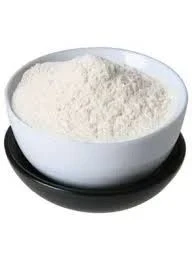
Dec . 29, 2024 19:42 Back to list
hpmc viscosity
Exploring HPMC Viscosity Key Factors and Applications
Hydroxypropyl Methylcellulose (HPMC) is a versatile and widely used cellulose derivative known for its unique properties, particularly its viscosity characteristics. The viscosity of HPMC is a critical parameter that impacts its applications across various industries, including pharmaceuticals, food, cosmetics, and construction. Understanding the factors that influence HPMC viscosity is essential for harnessing its full potential in different formulations and processes.
What is HPMC?
HPMC is a non-ionic, water-soluble polymer derived from natural cellulose. Through a chemical process involving hydroxypropylation and methylation, cellulose is modified to create HPMC. The degree of substitution (the extent to which hydroxyl groups in cellulose are replaced by hydroxypropyl and methyl groups) plays a crucial role in determining the properties of HPMC, including its solubility and viscosity.
Viscosity Characteristics of HPMC
The viscosity of HPMC solutions is dependent on several factors, primarily the concentration of HPMC, the molecular weight of the polymer, and the temperature of the solution. Generally, higher concentrations of HPMC yield higher viscosities. Likewise, polymers with greater molecular weights tend to produce more viscous solutions. This behavior is due to the increased hydrodynamic volume presented by larger HPMC chains, which results in greater resistance to flow.
Thermal conditions also play a significant role in the viscosity of HPMC solutions. As temperature increases, viscosity typically decreases. This is a common behavior observed in many polymer solutions and is attributed to the increased kinetic energy that allows polymer chains to move more freely, reducing overall resistance to flow.
Measuring Viscosity
The viscosity of HPMC can be measured using various methods, including rotational viscometers and capillary viscometers. Rotational viscometers are particularly common due to their ability to provide rapid and accurate viscosity measurements across a wide shear rate range, making them suitable for different formulation needs. It is imperative to select the appropriate measuring technique and conditions to accurately assess viscosity, considering the non-Newtonian behavior of HPMC solutions.
hpmc viscosity

Applications of HPMC Based on Viscosity
The viscosity of HPMC significantly influences its applications
1. Pharmaceuticals In the pharmaceutical industry, HPMC is used as a binder, coating agent, and thickening agent in drug formulations. The viscosity profile of HPMC can affect the release rate of active pharmaceutical ingredients (APIs) in controlled-release applications, making it crucial for optimizing drug delivery systems.
2. Food Industry HPMC is employed as a thickening agent, emulsifier, and stabilizer in food products. Its viscosity properties help improve texture and mouthfeel in various food applications, ranging from sauces and dressings to baked goods and dairy products.
3. Cosmetics In cosmetics and personal care products, HPMC acts as a thickening agent, providing desirable consistencies and enhancing product stability. The viscosity of HPMC solutions can affect the sensory characteristics of creams, lotions, and gels, thus playing a vital role in consumer acceptability.
4. Construction HPMC is widely used in construction materials, particularly in cement-based systems. It improves workability, water retention, and adhesion properties of mortar and tile adhesives, significantly influencing the performance of construction applications.
Conclusion
In summary, the viscosity of Hydroxypropyl Methylcellulose is a critical property that influences its performance and application across various fields. By effectively manipulating factors such as concentration, molecular weight, and temperature, formulators can tailor the viscosity of HPMC to meet specific needs. As industries continue to seek innovative solutions for improving product performance, understanding and controlling HPMC viscosity will remain paramount. This multifaceted polymer will undoubtedly continue to play a key role in advancing formulations across diverse applications, demonstrating the importance of ongoing research and development in this area.
-
Versatile Hpmc Uses in Different Industries
NewsJun.19,2025
-
Redispersible Powder's Role in Enhancing Durability of Construction Products
NewsJun.19,2025
-
Hydroxyethyl Cellulose Applications Driving Green Industrial Processes
NewsJun.19,2025
-
Exploring Different Redispersible Polymer Powder
NewsJun.19,2025
-
Choosing the Right Mortar Bonding Agent
NewsJun.19,2025
-
Applications and Significance of China Hpmc in Modern Industries
NewsJun.19,2025







